[GUIDE] How Long To Cook Hamburger Sliders In Oven
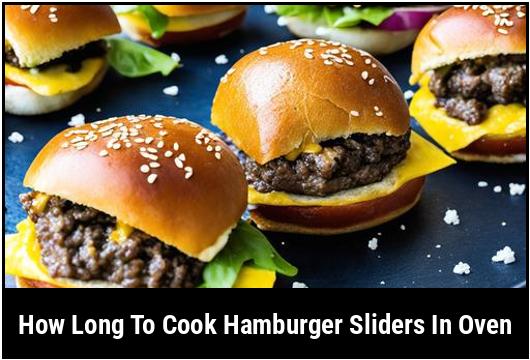
Hamburger sliders are a delicious and popular snack or meal option that can be enjoyed by people of all ages. These mini-sized burgers are not only convenient to eat, but they also offer a wide range of flavor possibilities. One of the most common methods of cooking hamburger sliders is in the oven. This cooking method ensures that the patties are cooked evenly and allows for easy preparation of multiple sliders at once.
If you’re wondering how long it takes to cook hamburger sliders in the oven, the answer can vary depending on several factors such as the cooking temperature, the thickness of the patties, and personal preference for doneness. In this article, we will delve into the details of cooking hamburger sliders in the oven, providing you with all the information you need to achieve perfectly cooked and delicious sliders every time.
Quick Answer: How Long To Cook Hamburger Sliders In Oven
The average cooking time for hamburger sliders in the oven is approximately 10-12 minutes at a temperature of 400°F (205°C). However, it’s crucial to note that this is an estimate, and the actual cooking time can vary based on various factors. It’s always recommended to use a meat thermometer to ensure that the internal temperature of the patties reaches a safe level of 160°F (71°C) for ground beef.
Key Takeaways
- Cook hamburger sliders at an oven temperature of 400°F (205°C).
- The average cooking time for hamburger sliders is 10-12 minutes.
- Use a meat thermometer to ensure the internal temperature is 160°F (71°C).
- Preparing sliders with lean ground beef and proper seasoning ensures flavorful results.
The Science Of Cooking Hamburger Sliders
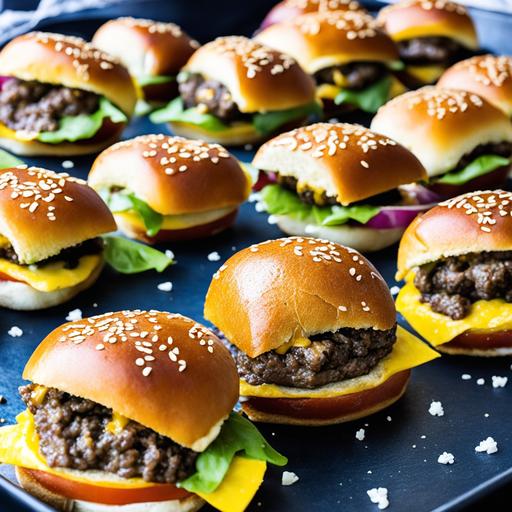
Understanding the science of cooking hamburger sliders can help you achieve optimal results. When ground beef patties are cooked, several processes occur that affect the texture and flavor of the final product.
Firstly, the heat causes the proteins in the ground beef to denature and coagulate, resulting in the formation of a firm patty. As the cooking process continues, the Maillard reaction takes place, creating a brown and flavorful crust on the surface of the patties. Additionally, the fat within the ground beef begins to render, adding moistness and juiciness to the sliders.
By controlling the temperature and cooking time, you can ensure that these processes occur correctly and result in a tender, juicy, and well-flavored hamburger slider.
Choosing Hamburger Sliders
The quality of the ground beef used for your hamburger sliders plays an essential role in the overall flavor and texture of the final product. Here are some tips for choosing the best ground beef for your sliders:
-
Fat Content: Ground beef with a fat content of approximately 15-20% is ideal for juicy and flavorful sliders. The fat helps to maintain moisture during the cooking process, preventing the sliders from becoming dry.
-
Freshness: Ensure that the ground beef is fresh and has not exceeded its expiration date. Fresh ground beef will have a vibrant color and a pleasant smell.
-
Lean vs. Fatty: If you prefer leaner sliders, you can opt for ground beef with a lower fat content (e.g., 7-10%). However, keep in mind that leaner ground beef can result in drier sliders, so it’s essential to take extra care during cooking to prevent them from becoming overcooked.
Preparing Hamburger Sliders
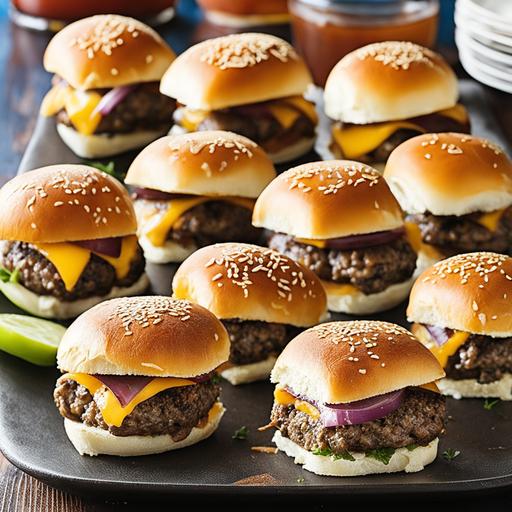
Properly preparing the hamburger sliders before cooking is crucial for achieving optimal results. Here’s how you can prepare the sliders:
-
Seasoning: Add your desired seasonings to the ground beef. Common options include salt, pepper, garlic powder, onion powder, and Worcestershire sauce. Mix the seasonings into the ground beef evenly using your hands or a spoon.
-
Forming Patties: Divide the seasoned ground beef into equal portions, depending on the desired size of your sliders. Gently shape each portion into a ball and then flatten it to form a patty. Ensure that the patties are of even thickness throughout.
-
Indentation Tip: Make a slight indentation in the center of each patty using your thumb or the back of a spoon. This indentation helps to prevent the patties from puffing up in the center during cooking, ensuring even cooking throughout.
-
Resting Time: Allow the patties to rest at room temperature for about 15-20 minutes before cooking. This resting period allows the flavors to meld together and results in a more flavorful end product.
Ideal Cooking Temperature For Hamburger Sliders
Cooking hamburger sliders at the right temperature is crucial for achieving the desired doneness and flavor. The ideal cooking temperature for hamburger sliders is 400°F (205°C). This temperature ensures that the patties cook evenly and develop a golden-brown crust on the outside while remaining juicy and tender on the inside.
Cooking burgers at lower temperatures may result in undercooked or overly moist sliders, while higher temperatures can cause the exterior to burn before the interior is fully cooked.
Hamburger Sliders Cooking Time
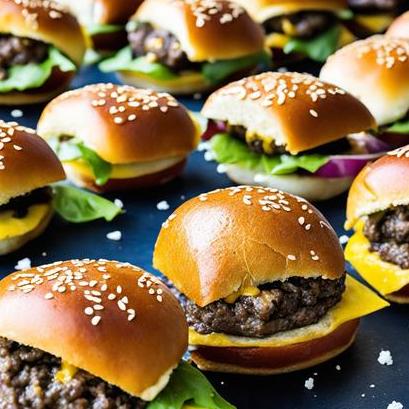
The cooking time for hamburger sliders can vary depending on several factors, including the thickness of the patties, the desired level of doneness, and the specific oven being used. On average, hamburger sliders take approximately 10-12 minutes to cook in the oven at a temperature of 400°F (205°C). However, it’s crucial to monitor the cooking process closely and make adjustments as necessary.
To ensure that the sliders are cooked to a safe internal temperature, use a meat thermometer. Insert the thermometer into the thickest part of the patty, making sure not to touch the bone or the pan. The internal temperature should reach 160°F (71°C) for ground beef to ensure that any potential bacteria or pathogens are destroyed.
It’s also worth noting that cooking time alone is not a definitive indicator of doneness. The presence of a proper brown crust on the outside and juicy interior are key visual cues for cooked hamburger sliders.
Cooking Techniques
When cooking hamburger sliders in the oven, there are a few techniques you can employ to enhance their flavor and texture. Here are some pro tips:
-
Searing: To achieve a flavorful caramelized crust, you can sear the patties before transferring them to the oven. Heat a skillet over high heat and add a small amount of oil. Sear the sliders on each side for about 1 minute until they develop a brown crust. Then, transfer them to a baking sheet and continue cooking in the oven as instructed.
-
Basting: Basting the sliders with melted butter or a marinade can help enhance their flavor and moistness. Brush the butter or marinade onto the sliders during the cooking process, ensuring not to apply too much to avoid overpowering the natural flavors of the meat.
-
Cheese Melting: If you prefer cheese on your sliders, you can add it during the last few minutes of cooking. Sprinkle grated or sliced cheese on top of the sliders and return them to the oven until the cheese melts and becomes gooey.
-
Broiling: For a slightly charred and crispy exterior, you can broil the sliders for the last 1-2 minutes of cooking. Keep a close eye on them during this step to prevent burning.
Monitoring And Troubleshooting
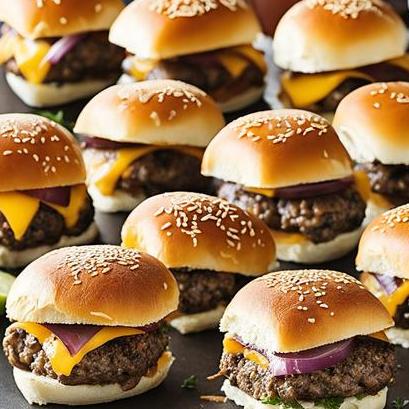
During the cooking process, it’s essential to monitor the sliders closely to avoid undercooking or overcooking. Here are some tips for monitoring and troubleshooting:
-
Timer: Set a timer to ensure you don’t forget about the sliders while they’re cooking. However, note that the cooking time provided is an estimate, and individual ovens may vary. Always rely on visual cues and the internal temperature to determine doneness.
-
Meat Thermometer: Use a meat thermometer to check the internal temperature of the sliders. Insert it into the thickest part of the patty without touching the pan or bone. The internal temperature should read 160°F (71°C) for ground beef to ensure safety.
-
Adjusting Cooking Time: If the sliders are not cooked to your desired level of doneness within the estimated cooking time, you can leave them in the oven for an additional minute or two. Test the internal temperature frequently with a thermometer until it reaches 160°F (71°C).
-
Size Consistency: Ensure that the patties are of similar thickness and size for even cooking. Thicker patties may require a slightly longer cooking time, while thinner ones may cook faster.
-
Resting Time: After removing the sliders from the oven, let them rest for a few minutes before serving. This allows the juices to redistribute within the patties, resulting in a juicier and more flavorful end product.
Hamburger Sliders Cooking Instructions
Now that you have a good understanding of the science behind cooking hamburger sliders and the various techniques involved, let’s get into the step-by-step cooking instructions:
-
Preheat the oven: Preheat your oven to 400°F (205°C). This ensures that the oven is at the desired temperature when you’re ready to cook the sliders.
-
Prepare the patties: Season the ground beef with your desired seasonings and mix well. Divide the ground beef into equal portions and shape them into patties. Make a slight indentation in the center of each patty to prevent them from puffing up during cooking.
-
Place on a baking sheet: Arrange the patties on a baking sheet, leaving some space between them to ensure even cooking. You can line the baking sheet with parchment paper or lightly oil it to prevent sticking.
-
Cook in the oven: Place the baking sheet with the patties in the preheated oven. Cook the sliders for approximately 10-12 minutes or until the internal temperature reaches 160°F (71°C). Keep a close eye on the patties and adjust the cooking time if necessary.
-
Optional: If you prefer, you can baste the sliders with melted butter or a marinade during the cooking process to enhance their flavor.
-
Cheese melting (optional): If desired, add grated or sliced cheese to the sliders during the last few minutes of cooking. Return them to the oven until the cheese melts and becomes gooey.
-
Rest before serving: Once cooked, remove the sliders from the oven and allow them to rest for a few minutes before serving. This resting period allows the juices to redistribute within the patties, resulting in a more flavorful end product.
Variations
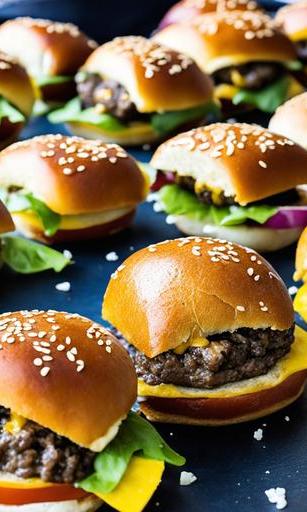
While the classic hamburger slider is made with ground beef, there are several variations you can explore to add variety to your cooking. Here are a few ideas:
-
Turkey Sliders: Replace the ground beef with ground turkey for a leaner option. Keep in mind that turkey sliders may require a slightly shorter cooking time than beef sliders to avoid drying out.
-
Chicken Sliders: Ground chicken can be used as an alternative to beef. To enhance the flavor, consider adding herbs and spices such as paprika, thyme, or cayenne pepper to the ground chicken.
-
Veggie Sliders: For a vegetarian or vegan option, you can make sliders using a mixture of vegetables and legumes. Popular choices include black bean sliders, lentil sliders, or mushroom sliders. Ensure that the mixture has a good binding agent to hold the sliders together.
-
Cheese-Stuffed Sliders: Add a surprise burst of cheese by shaping the ground beef around a small cube of cheese before cooking. This results in a gooey, melted cheese filling when the sliders are cooked.
-
Flavorful Toppings: Experiment with various toppings to add flavor and texture to your sliders. Some options include caramelized onions, sautéed mushrooms, bacon, avocado slices, or a variety of sauces and spreads.
Remember to adjust the cooking time and temperature accordingly when using variations to ensure the desired level of doneness.
When Things Go Wrong
Cooking hamburger sliders in the oven is generally a straightforward process. However, various issues can arise that may affect the outcome. Here are some common problems and their solutions:
-
Dry Sliders: Dry sliders can result from using lean ground beef or overcooking the patties. To prevent this, choose ground beef with a higher fat content or add a small amount of fat (such as butter) into the ground beef mixture. Additionally, reduce the cooking time by a couple of minutes to avoid overcooking.
-
Raw or Undercooked Sliders: If the sliders are still raw or undercooked in the center, extend the cooking time by a few minutes. Check the internal temperature with a meat thermometer until it reaches 160°F (71°C).
-
Overcooked Sliders: Overcooked sliders can occur if the cooking temperature is too high or the cooking time is too long. Adjust the temperature to 400°F (205°C) and reduce the cooking time by a minute or two for subsequent batches.
-
Sliders Falling Apart: If the sliders fall apart while cooking, it may be due to insufficient binding agents or excessive handling. Ensure that your ground beef mixture has adequate binding ingredients such as egg or breadcrumbs. Additionally, handle the patties gently and avoid pressing them during cooking.
By identifying and addressing these issues, you can troubleshoot and achieve better results with your hamburger sliders.
Serving Hamburger Sliders
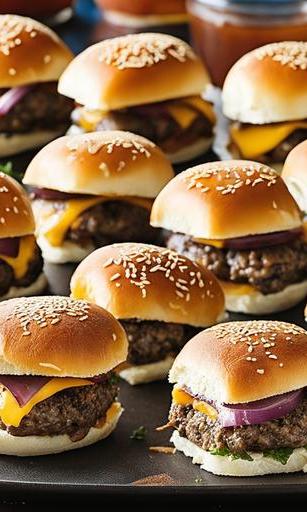
Once the hamburger sliders are cooked to perfection, it’s time to enjoy them! Here are a few serving suggestions to make your sliders even more delightful:
-
Buns: Serve your sliders on small buns or mini slider rolls. You can choose from various options, such as sesame seed buns, potato rolls, or whole wheat buns.
-
Toppings: Add your favorite toppings to the sliders to enhance their flavor. Common options include lettuce, tomato, onion, pickles, cheese, and various condiments such as ketchup, mustard, or mayo.
-
Side dishes: Serve your sliders with a variety of side dishes to create a complete meal. Consider options like French fries, sweet potato fries, coleslaw, or a refreshing salad.
-
Presentation: Arrange the sliders on a platter or a wooden board for an appealing presentation. You can spear each slider with a toothpick to keep them together and make them easier to serve.
Best Practices For Hamburger Sliders Cooking
To achieve the best possible results when cooking hamburger sliders in the oven, keep the following tips in mind:
-
Use a meat thermometer: A meat thermometer is an essential tool for ensuring that the sliders are cooked to a safe internal temperature. This ensures that any potential bacteria or pathogens are destroyed, ensuring food safety.
-
Seasoning: Don’t be afraid to experiment with different seasonings and spices to elevate the flavor of your hamburger sliders. Consider incorporating ingredients such as Worcestershire sauce, garlic powder, onion powder, or smoked paprika for added depth of flavor.
-
Resting time: Allowing the cooked sliders to rest for a few minutes before serving is crucial. This resting period allows the juices inside the patties to redistribute, resulting in a more flavorsome and tender end product.
-
Size consistency: Ensure that the patties are of similar size and thickness for even cooking. This consistency helps to ensure that all sliders are cooked to the desired level of doneness at the same time.
-
Experiment with toppings and variations: Don’t be afraid to explore different toppings and variations to cater to your taste preferences. Adding unique ingredients or experimenting with different meats can add excitement and variety to your hamburger sliders.
-
Practice food safety: Always handle ground beef with clean hands and follow proper food safety guidelines to prevent cross-contamination. Ensure that the ground beef is cooked to the recommended internal temperature of 160°F (71°C) to ensure safe consumption.
Conclusion
Cooking hamburger sliders in the oven is a simple and convenient way to prepare a crowd-pleasing meal or snack. By following the recommended cooking temperature, time, and techniques, you can achieve juicy and flavorful sliders every time.
Ensure you choose quality ground beef, season it well, and monitor the cooking process using a meat thermometer for optimal results. By experimenting with different variations and toppings, you can customize your sliders to suit your personal preferences and create a memorable dining experience.
So, next time you’re craving a delicious and satisfying snack, fire up your oven, prepare some hamburger sliders, and enjoy the juicy goodness that these mini burgers have to offer!
FAQS
What Temperature Should I Set My Oven To When Cooking Hamburger Sliders?
The oven should be preheated to 350°F (180°C) before cooking hamburger sliders.
How Long Should I Cook Hamburger Sliders In The Oven?
The cooking time for hamburger sliders in the oven depends on the thickness of the patty and the desired level of doneness. Typically, it takes 10-15 minutes to cook sliders in the oven.
How Do I Know When My Hamburger Sliders Are Done Cooking?
The best way to ensure that your hamburger sliders are cooked thoroughly and safe to eat is to use a meat thermometer. The internal temperature should reach 160°F (71°C) for beef and 165°F (74°C) for ground turkey or chicken.
Do I Need To Flip My Hamburger Sliders While Cooking Them In The Oven?
Flipping the sliders is not necessary, but you may choose to do so if you desire a more even crust on both sides.
Can I Use A Baking Sheet Or A Baking Dish When Cooking Hamburger Sliders In The Oven?
Yes, you can use either a baking sheet or a baking dish to cook hamburger sliders in the oven. However, it’s important to make sure that the sliders are evenly spaced out and not touching each other to ensure even cooking.
Sources
About the Author Jenny
I'm Jenny, a housewife with an unwavering passion for food. My culinary journey began with my grandmother's kitchen, and it's now a full-fledged food blog. I've turned my love for cooking into a creative outlet, sharing recipes and stories with a global community of fellow food enthusiasts. It's proof that being a housewife can also mean pursuing your passions and savoring life's delectable moments.
